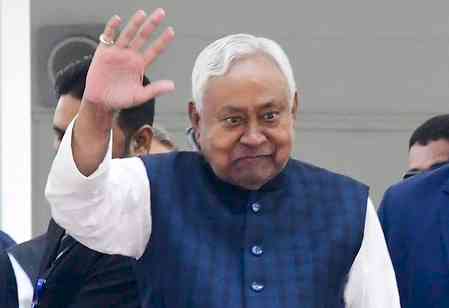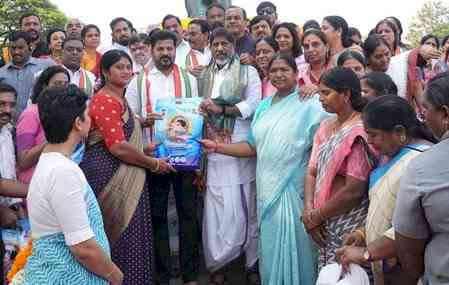India’s pharma exports nearing $30 billion, with CRDMOs and GCCs driving next phase of innovation: EY-Parthenon–OPPI report
As India aspires to become a $30 trillion to $35 trillion economy by 2047, the pharmaceutical industry is poised to play a critical role in driving economic growth and enhancing public health, as per a latest report by EY Parthenon and Organisation of Pharmaceutical Producers of India (OPPI). There are three interlinked pillars defining India's pharmaceutical industry: dominance in generics and vaccines, the advancing CRDMO/CDMO sector, and the expansion of Global Capability Centers.

Delhi, November 20, 2025: As India aspires to become a $30 trillion to $35 trillion economy by 2047, the pharmaceutical industry is poised to play a critical role in driving economic growth and enhancing public health, as per a latest report by EY Parthenon and Organisation of Pharmaceutical Producers of India (OPPI). There are three interlinked pillars defining India's pharmaceutical industry: dominance in generics and vaccines, the advancing CRDMO/CDMO sector, and the expansion of Global Capability Centers.
Titled "Fueling innovation, advancing equity: The power of partnerships and digital-first strategies driving Indian pharma's global dominance”, the report highlights the transformative journey of India's pharmaceutical sector as it evolves from its historical role as the "pharmacy of the world" to a global leader in innovation and scientific research.
Primary insights from CXO interactions amongst pharma majors indicate that the industry must focus on long-term global leadership and importance of transitioning from a cost-driven model to one focused on innovation and value creation. They further highlighted the necessity for regulatory agility, increased R&D investment, and talent development as critical areas for fostering a robust pharmaceutical ecosystem.
Reflecting on the report launch, Suresh Subramanian, National Lifesciences Leader, EY Parthenon India said, “India’s pharma sector has been a stellar success story. While we have established ourselves as a global leader in generics and vaccines, we face challenges in transitioning to high-value innovation and advanced therapeutics. Key areas such as regulatory ease, investment in next-generation therapies, and the development of a skilled workforce require urgent attention. Our report shows a clear path forward, powered by strategic partnerships, digital acceleration, and policy enablers that can help India evolve from a manufacturing hub to a global life sciences innovation powerhouse.”
Adding to it, Anil Matai, Director General, Organisation of Pharmaceutical Producers of India said, “India's pharmaceutical industry stands at a pivotal moment, with the potential to redefine its global identity through innovation and collaboration. By focusing on high-value opportunities, enhancing regulatory frameworks, and fostering partnerships among stakeholders, India can solidify its position as a leader in pharmaceutical innovation and advanced manufacturing by 2047. The collective efforts of industry, government, and academia will be essential in realizing this vision, ensuring that India not only meets its ambitious economic goals but also contributes significantly to global health and well-being.
Key takeaways from the report:
1. Current Landscape: Strengths and Opportunities
The report highlights India's position as one of the fastest-growing large economies, with its GDP soaring from $2.1 trillion to $4.3 trillion over the past decade. The government aims to transform the country into a $30 trillion to $35 trillion economy by 2047, with the pharmaceutical sector as a cornerstone of this ambition. Currently, the industry ranks third globally in volume and fourteenth in value, accounting for approximately 20% of the global supply of generic drugs and 60% of global vaccines.
Additionally, the report reveals that pharmaceutical exports have surged from $15.07 billion in 2013-14 to $27.85 billion in FY 2023-24, with projections to exceed $30 billion soon. This growth is not only vital for economic advancement but also crucial for public health, as a healthier population enhances labor participation and mitigates the economic impact of diseases.
2. Rise of CRDMOs: Transforming the Landscape
The report emphasizes the emergence of Contract Research and Development Organizations (CRDMOs) and Contract Development and Manufacturing Organizations (CDMOs) as pivotal players in the pharmaceutical landscape. The global CRDMO market is projected to reach $303 billion by 2028, growing at a CAGR of 9.0%. This growth is driven by pharmaceutical companies increasingly outsourcing R&D and manufacturing to focus on core competencies.
Furthermore, the report finds that Indian CRDMOs are investing heavily in advanced manufacturing and analytics, positioning themselves as key partners in global research and development. This evolution allows India to transition from a low-cost production hub to an integrated partner in high-value innovation, enabling participation in cutting-edge science and technology.
3. Expansion of Global Capability Centers: Embedding Innovation
The establishment and expansion of Global Capability Centers (GCCs) by multinational pharmaceutical firms in India, is becoming critical to enhancing the country’s innovation ecosystem. Approximately 50% of leading global life sciences companies have set up GCCs in India, leveraging local talent and advanced digital capabilities.
These centers have evolved from mere cost-saving units to strategic assets that contribute significantly to enterprise-wide innovation and global business strategies. The report highlights that the integration of artificial intelligence, advanced analytics, and automation within GCCs is redefining drug discovery and development processes, positioning India as a global knowledge and innovation engine.
4. CXOs highlight critical gaps: The report captures a unanimous view from industry leaders, who express that the traditional generics model is becoming increasingly unsustainable due to price erosion and rising costs. They emphasise a pressing need to ‘upscale India's knowledge potential’ and build a ‘world-class R&D ecosystem.’ A key insight from these conversations is that ‘partnerships follow predictability,’ underscoring the critical need for strong intellectual property protection and regulatory clarity to attract the early-phase research that fuels true innovation.
A roadmap for global leadership
The report proposes a three-pronged strategy to unlock India’s $450 billion potential:
• Regulatory agility and policy leadership: Align Indian GMP standards with global benchmarks, participate actively in international forums, and create a CRDMO-specific regulatory pathway with Regulatory Data Protection (RDP) to enable early-phase trials and co-development.
• R&D investment and innovation financing: Drive high-risk research through public–private innovation funds for biologics, cell, and gene therapies. The report urges pharma companies to raise R&D spend beyond 10% of revenues and build co-innovation labs with academia and startups to bridge discovery and commercialization.
• Talent and capability development: Modernize academic curricula with AI/ML, bioinformatics, and regulatory science. Encourage collaboration between industry, CRDMOs, and GCCs to design job-ready programs, and link research grants to tangible outcomes such as IND filings.


 City Air News
City Air News 










